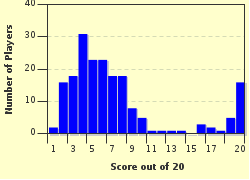Quiz Answer Key and Fun Facts
1. Long before there was any "combined" bombing offensive, there was only RAF Bomber Command. Growing from an insignificant series of pinpricks into a substantive effort, the first major milestone was reached with a large operation against the city of Köln (Cologne) on the night of 30/31 May, 1942. What was the RAF's codename for this mission?
2. Operation Millennium was a sobering glimpse of the future for those in the Reich's hierarchy who cared to see the writing on the wall. In this raid, the RAF employed a few tactical surprises that they'd held back prior to this raid. Of the following, which was NOT one of these "new tricks".
3. As the RAF evolved tactics during its bombing offensive, several "colorful" pieces of ordnance were evolved as well. One of these was a standard 4000lb high capacity (HC) casing, filled with benzol, rubber and phosphorus. What name did the RAF crews give to this particularly nasty device?
4. The year 1942 would see the introduction of the USAAF's VIII Bomber Command into the Allied order of battle. The first heavy bomber mission was flown against the railway marshalling yard in Rouen, with a diversionary feint to St. Omer. On what date was this mission flown?
5. The "Combined Bombing Offensive" as a doctrine did not actually exist during the early USAAF efforts. It arose as a band-aid resolution for squabbles between RAF and USAAF VIII Bomber Commands. On what date was the CBO directive actually ratified?
6. The directive which outlined the Combined Bombing Offensive was issued under which Operational title?
7. To prosecute the attack on German fighter production, it was determined that establishment of a bombing group based in Italy would be a priority if Messerschmitt's facilities in Austria were to be attacked. Which Air Force was created for this purpose?
8. Developed through constant innovation, by the summer of 1943 the Luftwaffe employed a highly evolved system by which they controlled their Nachtjäger forces. What name did they give this system?
9. One of the missions flown in Operation Gomorrah saw the first example of true "terror bombing"; all previous raids (no matter who conducted them) pale into insignificance by comparison. What were/was the date(s); which city was the target?
10. The raid that burned the heart out of Hamburg on July 27/28 1943 was the first large scale RAF raid that achieved adequate concentration of the bombing effort. This has been attributed to several factors; which of the following played the largest role over Hamburg that night?
11. The "Second Phase" of the USAAF's effort saw operations shift to German airspace; this was met with far greater resistance on the part of the Luftwaffe. Changes in German tactics were reported by the 8th AF, including all but which one of the following?
12. Sunday, 1 August 1943 saw the first large scale raid conducted against the oil facilities and transportation infrastructure at Ploesti in Romania. What was the code name given to this mission?
13. On 17 August 1943, the USAAF marked the anniversary of their entry into combat by launching an ambitious mission (which backfired badly). Which of the following statements about the Schweinfurt-Regensburg mission is false?
14. October 1943 saw the 8th AF make its final major attacks without deep fighter escort. Three missions in the period of "Black Week" led to a suspension of major deep penetration efforts for the remainder of the year. What were the targets?
15. The period November 1943-March 1944 saw Harris' "Battle of Berlin" missions flown. His assertion that it would "...cost Germany the war" proved a little over-optimistic. How many times did Bomber Command visit the German capital in strength during this period?
16. The USAAF returned to the skies over Germany in late February 1944, in a series of missions that were known by the euphemism "Big Week". What was the actual name for this operation?
17. The last months of "Operation Pointblank" (The Combined Bombing Offensive) saw the focus shift almost entirely to one specific target type. Upon what was the bulk of the tonnage directed?
18. Post war examination of the effects of the bombing effort identified one specific element that was virtually ignored and should have been assigned a much higher priority; what was it?
19. The entry of the P-51 Mustang into the order of battle was probably the most significant factor in the ultimate success of "Pointblank". Which Fighter Group was the first to be declared "operational" on the type?
20. The Merlin Mustang's combat debut was marred by a few notable "difficulties", although these were quickly addressed. Which of these was not a factor in this initial period of operations?
Source: Author
iron2
This quiz was reviewed by FunTrivia editor
bloomsby before going online.
Any errors found in FunTrivia content are routinely corrected through our feedback system.

